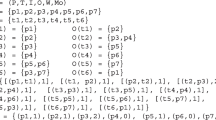Abstract
In the last decade, there has been a significant shift towards the use of machine learning (ML) within the technology industry. One prominent ML algorithm is the Tsetlin Machine (TM), where it uses a collection of learning automata to learn new patterns through propositional logic. While TMs are considered computationally simpler and more efficient than neural networks (NNs), there is difficulty in how TMs can be better understood by industrial practitioners. Although many approaches help demonstrate the benefits of TMs, there is however no approach that helps better explain the behaviour of TMs, e.g. how the TM’s decision is influenced by the initial states of their learning automata and how the TM’s learning is determined by the calculations made from its inference and feedback components. In this paper, we present the concept of event-driven TMs, where we model the complete behaviour of TMs using 1-safe Petri nets. The key aspects of Petri nets are their flexibility to model many types of specifications including distributed systems and concurrent systems, and their rich support from many well-established tools including Petrify, MPSat, and Workcraft. To highlight the benefits of our approach, we conduct a simple experiment where we showcase our Petri net specifying the complete behaviour of a TM, analyse its behaviour through a set number of epochs, and most importantly evaluate its accuracy.
Access this chapter
Tax calculation will be finalised at checkout
Purchases are for personal use only
Similar content being viewed by others
References
Workcraft (2006). https://workcraft.org/. Accessed 09 Jan 2024
Berge, G.T., Granmo, O.C., Tveit, T.O., Goodwin, M., Jiao, L., Matheussen, B.V.: Using the Tsetlin machine to learn human-interpretable rules for high-accuracy text categorization with medical applications. IEEE Access 7, 115134–115146 (2019). https://doi.org/10.1109/ACCESS.2019.2935416
Bhattarai., B., Granmo., O., Jiao., L.: Measuring the novelty of natural language text using the conjunctive clauses of a Tsetlin machine text classifier. In: International Conference on Agents and Artificial Intelligence (ICAART), pp. 410–417. INSTICC, SciTePress (2021). https://doi.org/10.5220/0010382204100417
Blakely, C.D.: Tsetlin LOB: realtime regime learning and interpretable prediction in financial limit orderbooks using convolutional Tsetlin machines. In: International Symposium on the Tsetlin Machine (ISTM), pp. 13–20 (2022). https://doi.org/10.1109/ISTM54910.2022.00012
Blakely, C.D., Granmo, O.-C.: Closed-form expressions for global and local interpretation of Tsetlin machines. In: Fujita, H., Selamat, A., Lin, J.C.-W., Ali, M. (eds.) IEA/AIE 2021. LNCS (LNAI), vol. 12798, pp. 158–172. Springer, Cham (2021). https://doi.org/10.1007/978-3-030-79457-6_14
Chu, T.: Synthesis of self-timed VLSI circuits from graph-theoretic specifications. Technical report, Massachusetts Institute of Technology, Department of Electrical Engineering and Computer Science (1987)
Cortadella, J., Kishinevsky, M., Kondratyev, A., Lavagno, L., Yakovlev, A.: Petrify: a tool for manipulating concurrent specifications and synthesis of asynchronous controllers. IEICE Trans. Inf. Syst. E80-D, 315–325 (1997)
Gill, A.: Introduction to the Theory of Finite-State Machines. McGraw-Hill, New York (1962)
Granmo, O.C.: The Tsetlin machine - a game theoretic bandit driven approach to optimal pattern recognition with propositional logic. arXiv preprint arXiv:1804.01508 (2018). https://arxiv.org/abs/1804.01508
Jensen, K.: Coloured Petri Nets: Basic Concepts, Analysis Methods and Practical Use, vol. 2. Springer, Heidelberg (1995). https://doi.org/10.1007/978-3-662-03241-1
Khomenko, V., Koutny, M., Yakovlev, A.: Logic synthesis for asynchronous circuits based on Petri net unfoldings and incremental SAT. In: International Conference Application of Concurrency to System Design (ACSD), pp. 16–25 (2004)
Lan, T., Mao, G., Xia, F., Yu, S., Shafik, R., Yakovlev, A.: An asynchronous Tsetlin automaton architecture with integrated non-volatile memory. In: International Symposium on the Tsetlin Machine (ISTM), pp. 37–40 (2022). https://doi.org/10.1109/ISTM54910.2022.00015
Maheshwari, S., et al.: REDRESS: generating compressed models for edge inference using Tsetlin machines. IEEE Trans. Pattern Anal. Mach. Intell. 45(9), 11152–11168 (2023). https://doi.org/10.1109/TPAMI.2023.3268415
Mao, G., Yakovlev, A., Xia, F., Lan, T., Yu, S., Shafik, R.: Automated synthesis of asynchronous Tsetlin machines on FPGA. In: IEEE International Conference on Electronics, Circuits and Systems (ICECS), pp. 1–4 (2022). https://doi.org/10.1109/ICECS202256217.2022.9970999
Mokhov, A., Rykunov, M., Sokolov, D., Yakovlev, A.: Towards reconfigurable processors for power-proportional computing. In: IEEE Faible Tension Faible Consommation (FTFC), pp. 1–4 (2013). https://doi.org/10.1109/FTFC.2013.6577770
Petri, C.A.: Kommunikation mit automaten (Communicating with automata). Ph.D. thesis (1962)
Rahman, T.: Tsetlin machine XOR demo (2021). https://github.com/tousifrahman/Tsetlin_Machine_XOR_demo. Accessed 16 Jan 2024
Rosenblum, L., Yakovlev, A.: Signal graphs: from self-timed to timed ones. In: International Workshop on Timed Petri Nets, pp. 199–206 (1985)
Tsetlin, M.L.: On behaviour of finite automata in random medium. Avtomat. i Telemekh 22(10), 1345–1354 (1961)
Wheeldon, A., Yakovlev, A., Shafik, R.: Self-timed reinforcement learning using Tsetlin machine. In: International Symposium Asynchronous Circuits and Systems (ASYNC), pp. 40–47 (2021). https://doi.org/10.1109/ASYNC48570.2021.00014
Acknowledgements
The authors would like to thank the anonymous reviewers for their feedback on this paper. This work was supported by EPSRC EP/X036006/1 as part of the Scalability Oriented Novel Network of Event Triggered Systems (SONNETS) project and by EPSRC EP/X039943/1 as part of the UKRI-RCN: Exploiting the dynamics of self-timed machine learning hardware (ESTEEM) project.
Author information
Authors and Affiliations
Corresponding author
Editor information
Editors and Affiliations
Rights and permissions
Copyright information
© 2024 The Author(s), under exclusive license to Springer Nature Switzerland AG
About this paper
Cite this paper
Chan, A., Wheeldon, A., Shafik, R., Yakovlev, A. (2024). Design of Event-Driven Tsetlin Machines Using Safe Petri Nets. In: Kristensen, L.M., van der Werf, J.M. (eds) Application and Theory of Petri Nets and Concurrency. PETRI NETS 2024. Lecture Notes in Computer Science, vol 14628. Springer, Cham. https://doi.org/10.1007/978-3-031-61433-0_17
Download citation
DOI: https://doi.org/10.1007/978-3-031-61433-0_17
Published:
Publisher Name: Springer, Cham
Print ISBN: 978-3-031-61432-3
Online ISBN: 978-3-031-61433-0
eBook Packages: Computer ScienceComputer Science (R0)




